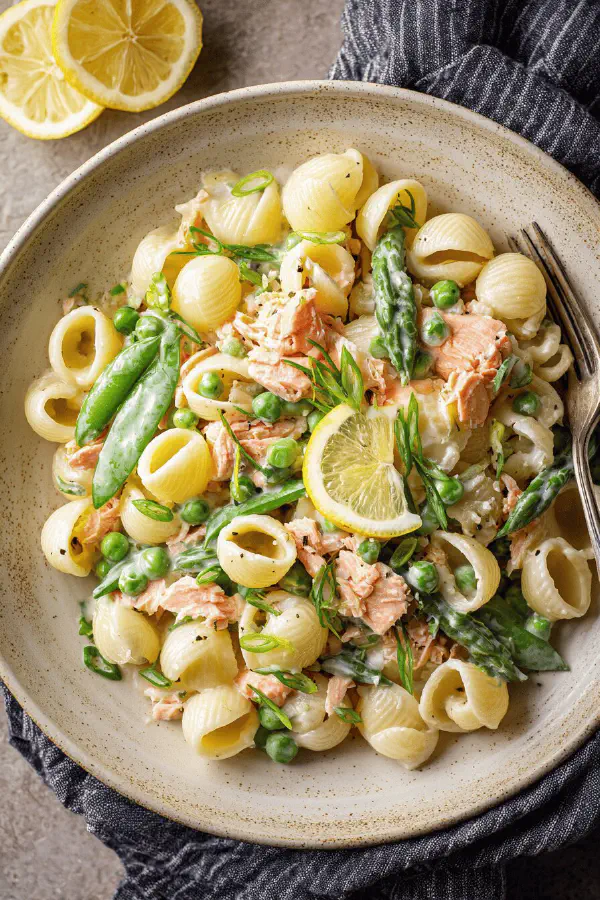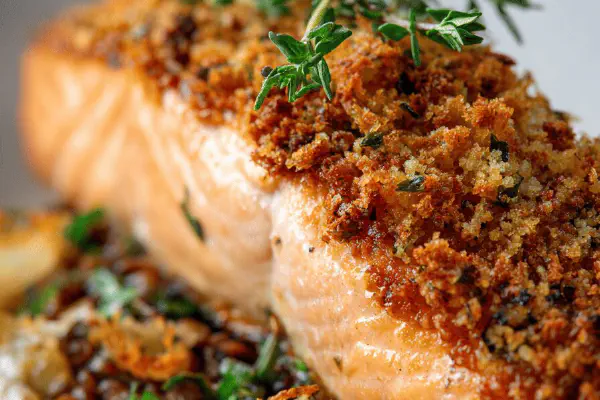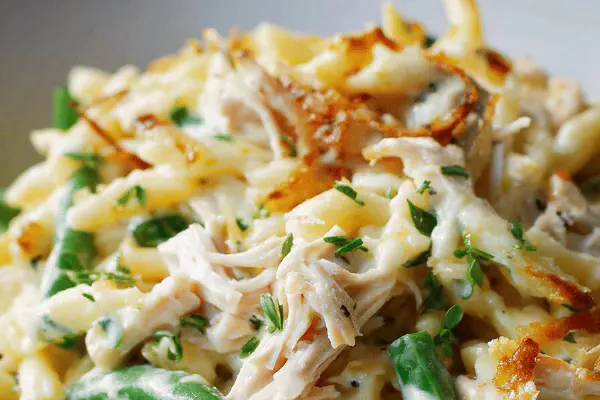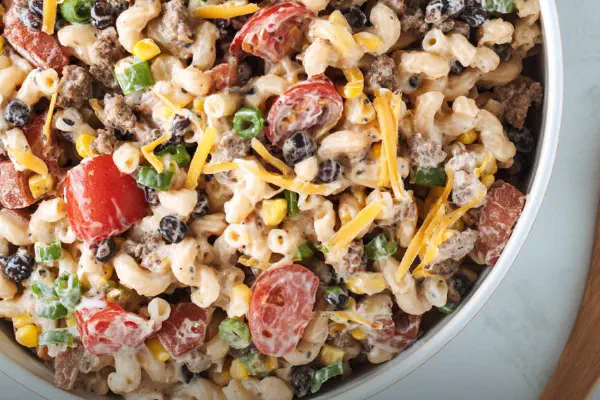Featured Recipe
Salmon Pea Shell Pasta

By Kate
"
A quick 30-minute meal combining shelled pasta, tender peas, and flaky salmon. Uses light cream and chicken broth for sauce, complemented by fresh green onions. A balanced dish with bright textures and rich protein.
"
Prep:
15 min
Cook:
15 min
Total:
30 min
Serves:
4 servings
pasta
salmon
quick meals
healthy recipes
30 minute meals
Introduction
Starting with boiling salted water. Pasta shells ready to catch every bite of sauce. Steam hisses from pan. Onions soften, scent builds. Peas add pops of sweetness and snap. Cream and broth swirl into silky, barely thick sauce. Salmon prepped, quick-steamed in microwave to keep moist, intact flakes. Lemon brightens, cuts fat just right. Timing’s tight but relaxed. Watch textures, not clocks. Don’t overcook peas; green vibrancy fades fast. Salmon should flake with light prodding, never crumble or dry. Simple prep maximizes flavor efficiency. This is quick weeknight fare that fills, pleases, and frees the cook to relax sooner. Master technique for multitasking kitchens. Good pasta like this? Takes sauce and protein all the way.
Ingredients
About the ingredients
Small shell pasta works great — its curved shape traps sauce like a bowl. If unavailable, use orecchiette or even conchiglie. The snap peas could be swapped for fresh sugar snap peas or snow peas, trimmed well; they provide a slightly different crunch but overall texture is key. Half and half cream balances richness and lightness; low-fat cream or even coconut milk are possible swaps but note flavor will shift. Vegetable broth replaced chicken broth to lighten and for plant-based option, but stock concentration affects final taste. Avocado oil has a clean flavor and high smoke point for salmon; olive oil is a direct substitute but use mild variety to avoid overpowering. Lemon zest wakes sauce gently; skip if unavailable but add finishing squeeze juice. Butter provides richness and emulsification with scallions; use light olive oil if dairy-free. Frozen peas frozen solid? Thaw slightly for quicker cooking and texture control.
Method
Technique Tips
Boil pasta until nearly al dente; it’ll finish cooking in sauce, saving time and preventing mush. Reserve pasta water — starch from cooking will bind sauce and keep everything cohesive. Sweating scallions slowly releases sweetness; avoid browning which signals bitterness and alters flavor. Snap peas must retain bite; cook too long and they lose characteristic crunch and vibrant color. The simmer time for sauce is brief, just to meld flavors and soften peas, not to reduce dramatically. Tossing pasta into sauce activates a marriage of starch and fat — watch for sauce clinging and slight thickening as moisture reduces. Microwave salmon speeds cooking but requires attention — power settings vary wildly. Test early and often with flake test. Flesh should separate easily but still look moist and translucent near center. Overcooked salmon dries and flakes apart harshly. Flake salmon gently to keep nice chunky texture in final dish. A lemon squeeze before serving is classic to lift richness. Salt and pepper at end critical — sauce intensity concentrates, seasoning early risks too salty final plate. These tweaks and disciplines separate good from forgettable.
Chef's Notes
- 💡 Boil water well salted; will flavor pasta. Look for bubbles; steady boil key. Salty water, crucial not to skimp. Cook pasta until just shy of al dente; it'll finish in sauce. Reserve that water, 100 ml at least; great for sauce later, keeping it cohesive. Don't let pasta stick; splash of oil helps.
- 💡 Scallions need to sweat gently; low and slow. No browning; bitter flavor ruins dish. Aromas here signal you're on right track. Snap peas should stay vibrant; 3 minutes max. Frozen peas add color. Cream and broth softens; about 4 minutes till flavors meld. Taste and adjust seasoning at end.
- 💡 Salmon should flake not crumble. Micro-cook for accuracy; don’t rush. Cover loosely. Start at 2 minutes; check. Should look moist, translucent inside. Adjust time based on wattage. Overcook turns it rubber like; avoid that. Gentle flaking keeps flakes intact, helpful for presentation.
- 💡 Experiment with substitutes; half and half can swap for low-fat cream or coconut milk. Flavor varies. Vegetable broth replaces chicken; keep it light. Love snap peas? For crunch, sugar snap peas work too. Olive oil good for salmon; use mild type to avoid overpowering.
- 💡 Final touch, lemon juice squeeze brightens flavors. Always season pasta at the end; salt concentration changes as sauce reduces. Be mindful of textures—pasta should cling sauce. Check seasoning in steps, small adjustments. Timing is tight; control is key for a balanced meal.
Kitchen Wisdom
Cooking time too long?
Watch pasta; it cooks with sauce. Check often. Keep it al dente but not mushy. Sauce thickens too; adjust heat as needed.
Saucy pasta issue?
Too dry, add pasta water slowly till it clings. Or, reduce heat more for gentle simmer. If too runny, increase heat; let reduce.
How to store leftover salmon?
Wrap it tight, fridge up to 2 days but flavor fades fast. Reheat gentle; microwave on low.
Substitutions for peas?
Frozen peas work; thaw slightly to speed. Fresh peas better if available. Snap or snow peas also work, trim well.



